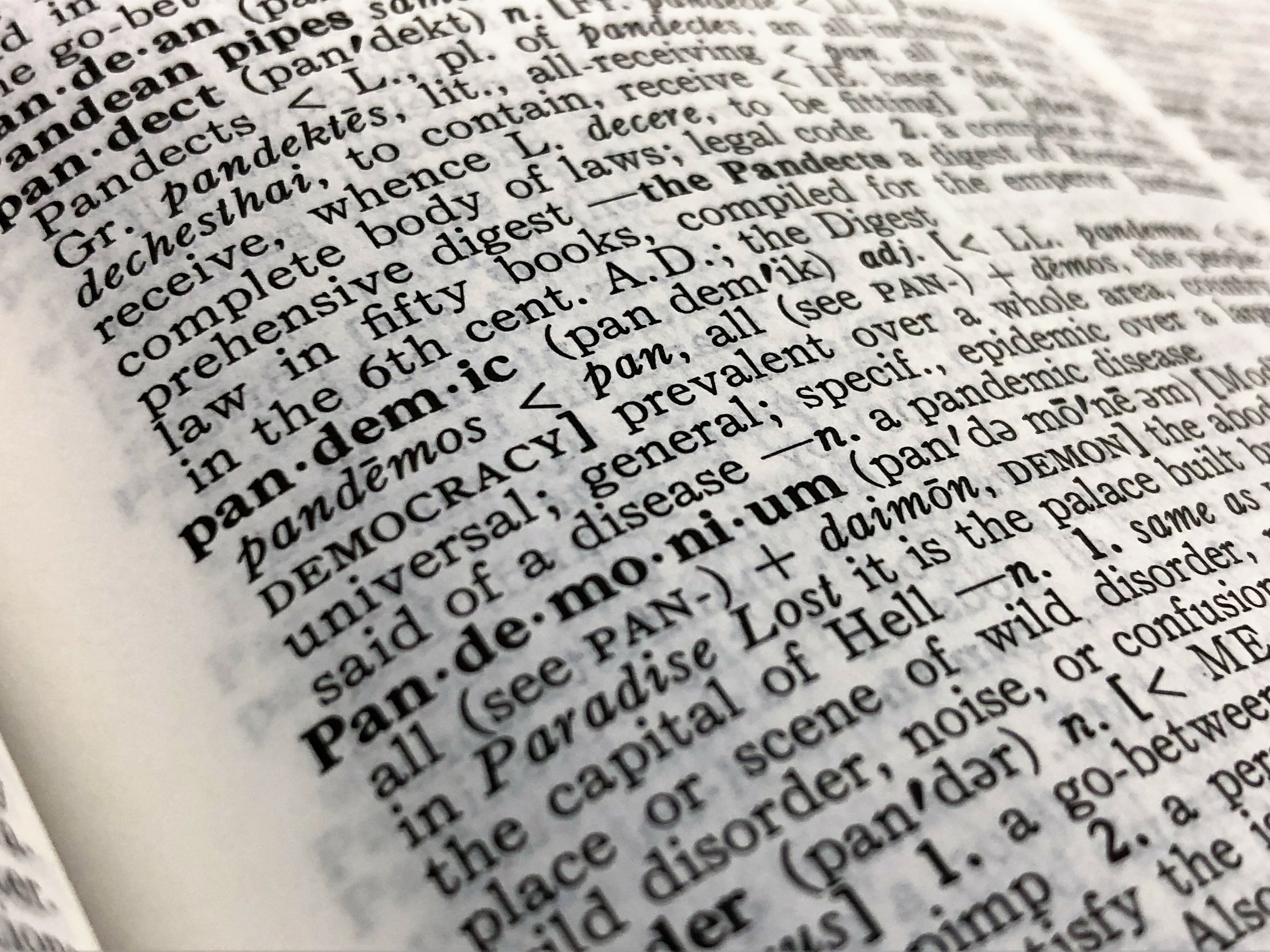
COVID-19 Glossary
Here’s a list of terms that are important to understanding the COVID-19 pandemic. (See CBJ’s full COVID-19 Glossary here.)
Asymptomatic transmission: The spread of COVID-19 from a person who is infected but never develops symptoms. In the case of COVID-19, this means absence of fever, dry cough, sore throat, shortness of breath and body aches, among other less common symptoms.
Close contact: A person who may be at risk of a contagious disease because of their proximity or exposure to a known case. The CDC defines close contact as being within approximately 6 feet (2 meters) of a COVID-19 case for a prolonged period of time (more than 10 minutes)
Cloth face covering: A material that covers the nose and mouth. It can be secured to the head with ties or straps or simply wrapped around the lower face. It can be made of a variety of materials, such as cotton, silk, or linen. A cloth face covering may be factory-made or sewn by hand, or can be improvised from household items such as scarfs, T-shirts, sweatshirts, or towels. Learn how to make your own mask at home without a sewing machine here. CDC also offers sew and no sew options.
Contact investigation is the public health approach to identifying other people who may have been exposed to a positive case. This is how it works:
- Once a positive case is found through testing, the Alaska Section of Epidemiology and the medical provider who ordered the test are notified by the lab (ether a state virology or private lab).
- Epidemiology communicates with the local Public Health center in the appropriate community.
- The Public Health Nurse or the client’s health care provider will contact the individual who tested positive. Contact investigation starts with the phone call to the client who tested positive.
- Questions are asked to determine when the client began to feel ill (onset of symptoms) and define their infection period. With COVID-19, a person is infectious two days prior to the onset of symptoms.
- Existing health problems that might increase a person’s risk of complications are identified.
- Activities from two days prior to symptom onset until current day are identified. The goal is to identify who else may have been exposed while the client was infectious.
- The client is also asked about activities 14 days before symptom onset in order to determine where/who the virus came from.
- The client provides a list of potential contacts.
- The client receives information on quarantine, isolation, symptoms, etc.
- The Public Health Nurse communicates with any determined to be a close contact to provide educational information such as how to monitor symptoms and what testing options are available.
- The client and close contacts will be called daily until they are cleared from isolation or quarantine
COVID-19: On February 11, 2020 the World Health Organization announced an official name for the disease that is causing the 2019 novel coronavirus outbreak. The new name of this disease is coronavirus disease 2019, abbreviated as COVID-19. In COVID-19, ‘CO’ stands for ‘corona,’ ‘VI’ for ‘virus,’ and ‘D’ for disease.
Epidemiology: A branch of medical science that deals with the incidence, distribution, and control of disease in a population. The Alaska Section of Epidemiology is often referred to as “epi.”
Flatten the curve: The curve represents the number of people who contract COVID-19 over a period of time. Flattening the curve means to stagger the number of new cases over a longer period, so the health care system isn’t overwhelmed and people have better access to care.
Isolation: Separates sick people with a contagious disease from people who are not sick. Isolation applies to those who display COVID-19 symptoms, those awaiting test results, and those who received positive test results but don’t require hospitalization. Isolation and quarantine help protect the public by preventing exposure to infected individuals or to individuals who may be infected.
N95 respirator: Also referred to as an “N95 mask,” this personal protective equipment is worn on a providers’ faces, forming a tight seal around the nose and mouth. Though it looks like a surgical mask, an N95 is actually a respirator that filters out at least 95% of particles in the air. The CDC does not recommend N95 respirators for public use. Medical staff who use N95 masks get fit for them yearly to ensure the mask will protect them.
Pandemic: A global outbreak of disease. Pandemics happen when a new virus emerges to infect people and can spread between people sustainably. Because there is little to no pre-existing immunity against the new virus, it spreads worldwide. The virus that causes COVID-19 is infecting people and spreading easily from person-to-person. Cases have been detected in most countries worldwide and community spread is being detected in a growing number of countries. On March 11, the COVID-19 outbreak was characterized as a pandemic by the World Health Organization.
PPE: Personal protective equipment, or PPE, is used every day by healthcare personnel to protect themselves, patients, and others when providing care. PPE helps protect healthcare personnel from potentially infectious patients and materials, toxic medications, and other potentially dangerous substances used in healthcare delivery. In health care settings, PPE may include gloves, gowns, aprons, masks, respirators, goggles, and face shields. PPE shortages are currently posing a tremendous challenge to the US healthcare system because of the COVID-19 pandemic.
Presymptomatic: A person who’s been infected and is incubating the virus but doesn’t yet show symptoms.
PUI: Person under investigation, or a PUI, is an individual who is suspected of potentially having COVID-19.
Quarantine: Separates and restricts the movement of people who were exposed to a contagious disease to see if they become sick. Quarantine (for 14 days to see if symptoms develop) applies to certain travelers and others who may have been exposed to COVID-19. Isolation and quarantine help protect the public by preventing exposure to infected individuals or to individuals who may be infected.
Recovered: An individual who’s recovered from COVID-19 is no longer infectious. The Alaska Department of Health and Social Services considers a person recovered based on the following guidelines:
- Fever has to be completely gone for at least 3 days (72 hours) without the use of fever-reducing medications; AND,
- Improvement in respiratory symptoms (e.g., cough, shortness of breath); AND,
- At least 7 days have passed since symptoms first appeared.
The Section of Public Health Nursing determines this criteria through daily interviews with the infected person and in conjunction with their primary provider. People who are recovered should still practice social distancing and other preventive measures.
Screening for COVID-19 is a series of questions asked to determine a person’s risk for COVID-19. They include questions about symptoms, travel history in recent weeks, and exposure to someone who has been confirmed to have COVID-19.
Social distancing, also called “physical distancing,” means keeping space between yourself and other people outside of your home. To practice social or physical distancing:
- Stay at least 6 feet (2 meters) from other people
- Do not gather in groups
- Stay out of crowded places and avoid mass gatherings
Types of cases: When giving updates on local COVID-19 case counts, CBJ sometimes refers to acquisition of the disease or the source of the virus. CBJ uses the same categories as the State of Alaska:
- Travel – Cases attributed to travel were outside of Alaska during some or all of their exposure period in a location with known COVID-19 cases (either international or within the US).
- Secondary – Cases attributed to secondary transmission were a contact to a confirmed Alaskan case, often within a household.
- Community – Cases attributed to community spread were interviewed to ascertain their source of exposure or index case, but none could be determined. Their exposure was potentially an undiagnosed case within the community or an unnamed connection to another confirmed case.
